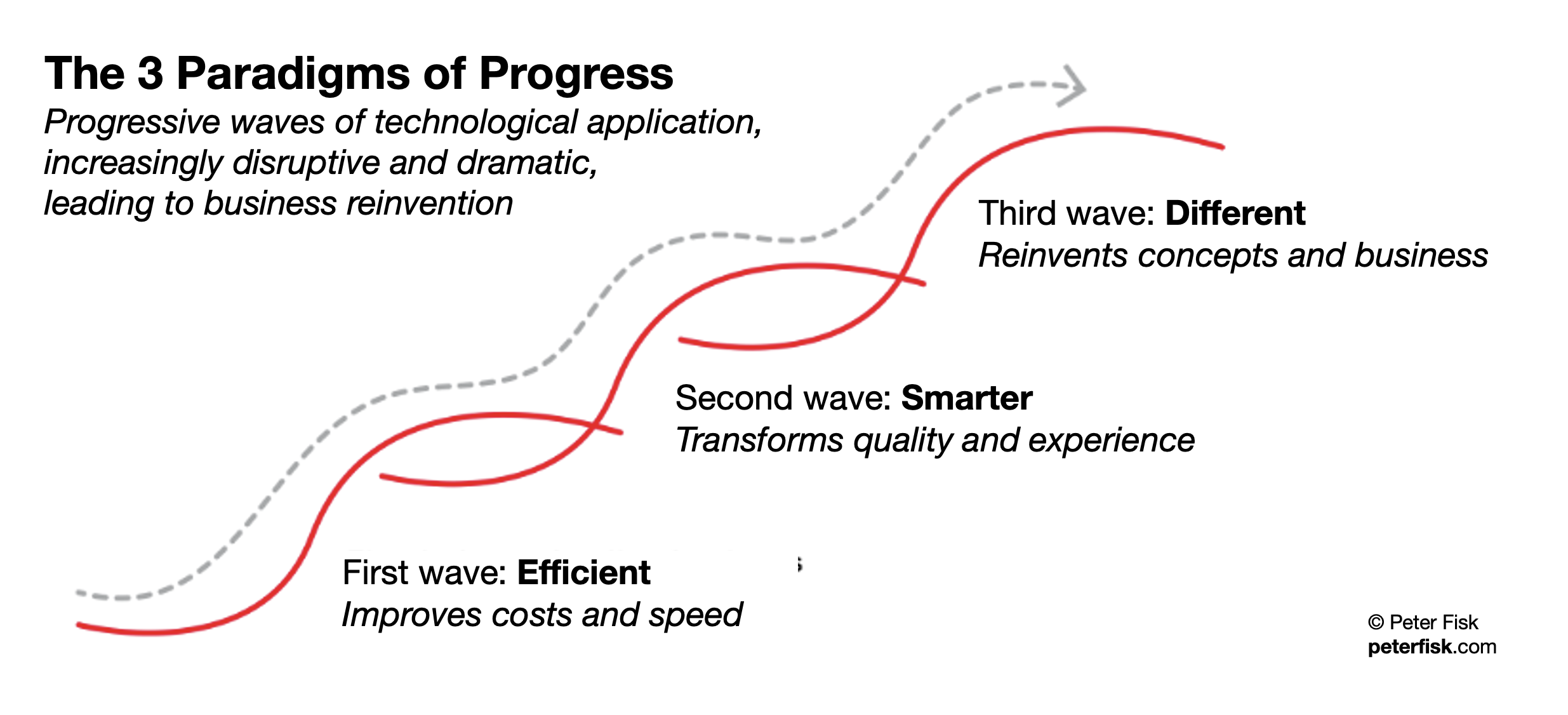The 3 Paradigms of Progress … how technology transforms markets in three waves … Progress isn’t just about doing things faster. It’s about doing them smarter, and ultimately, differently
May 21, 2025

We’re bombarded by the hype of AI. It will transform our world, every industry, every task. And it probably will, eventually. But it also feels like not much has changed. Yes we listen to music, navigate maps, and search information differently. But is doesn’t feel like a revolution. Yet.
Technological revolutions rarely arrive all at once.
They unfold in waves, each one reshaping how we work, live, and think. From electricity to the internet to artificial intelligence, transformative technologies follow a pattern of adoption that moves through three distinct paradigms of progress.
These can be seen as successive S-curves of change, where the initial promise evolves into deeper reinvention.
-
Doing things efficiently
-
Doing things smarter
-
Doing things differently
Understanding these three paradigms is essential for leaders, innovators, and societies seeking to harness new technologies not just for marginal gains, but in time for fundamental transformation.

Think about how AI has the potential to transform customer service, for example – initially by making processes faster or cheaper, then by enhancing services through more intelligence or personalisation, but eventually by completely reinventing services and the user experiences.
Or consider banking. Initially AI improved efficiency, automating services, and reducing fraud. Now we see a new generation of products, from embedded payments to peer to completely new services. The real shift will come in the third wave, making banks anticipative, connected, and invisible.
We can see the same three s-curves playing out in every sector, from retail to automotive, finance and entertainment, doctors and lawyers. Maybe slowly at first, but the drama and disruption will definitely come. And yet most companies get stuck on the first wave. Their mindset is fixed, limited by what they know, and seeking to improve the known.
The opportunity is to ride the waves of progress, and ultimately to unlock the new possibilities, to reinvent your business.
How far are you willing to go?
1. Doing Things More Efficiently
“Let’s do what we’ve always done—just faster, cheaper, or with fewer people.”
In the first phase of any major technology adoption, organizations use it to streamline existing processes. The focus is operational efficiency: reduce costs, automate repetitive tasks, and increase productivity. Technology is seen as a tool to optimize the status quo.
Consider artificial intelligence. The earliest commercial applications of AI were centered around automating call centers, tagging images, processing invoices, or assisting with code generation. In each case, the work being done remained largely the same—but now it could be done quicker and with fewer resources.
Historical parallels abound. The arrival of electricity didn’t immediately lead to new kinds of factories—it simply replaced steam engines. It took decades for architects and engineers to redesign factories in ways that leveraged electric power’s full flexibility.
Efficiency is a seductive starting point because it promises fast returns and low risk. But it’s also the least transformative.
Technology is used to optimize existing operations.
-
Amazon (early years): Initially applied algorithms and automation to optimize warehouse logistics and online order fulfillment—doing traditional retail more efficiently at scale.
-
Banks & Financial Services: Robotic process automation (RPA) is widely used to handle repetitive tasks like onboarding, compliance checks, or data entry, saving time and labor but not transforming the service itself.
-
Legal industry: Tools like e-discovery platforms and contract review software use AI to speed up document analysis—reducing billable hours, but still following the same legal workflows.
2. Doing Things Smarter
“Let’s use technology to improve the quality, experience, and outcomes of what we do.”
Once technology proves its utility, a second paradigm emerges: using it to enhance outcomes, not just reduce inputs. This is about improving quality, personalization, speed, accuracy, and scale in meaningful ways.
With AI, this might mean using large language models not just to draft documents faster, but to generate better insights, recommendations, or creative content. In healthcare, AI shifts from automating administrative tasks to supporting better diagnoses. In education, it moves from grading tests to creating adaptive learning experiences tailored to each student.
At this stage, industries begin to rethink customer value. Products become services. Services become platforms. Decisions become more data-driven. Human-AI collaboration becomes a strength, not a threat.
This second curve usually requires more investment, redesign, and cultural change—but it also starts to deliver deeper competitive advantages. Still, it often works within the current paradigm of how business is structured.
-
Spotify: Goes beyond delivering digital music efficiently. Its recommendation engine uses machine learning to personalize listening experiences, improving engagement and satisfaction.
-
Tesla: Uses AI not just to manufacture cars more efficiently but to deliver a better product—integrating software updates, self-driving capabilities, and connected services that continuously improve over time.
-
Healthcare providers: Mayo Clinic and others use AI to assist with diagnosis, image analysis, and treatment recommendations—resulting in better patient outcomes rather than just administrative savings.
3. Doing Things Differently
“Let’s reimagine what’s possible. Let’s create entirely new ways of solving problems.”
The final paradigm is the most powerful—and the most disruptive. Here, technology enables us to do things we couldn’t do before, in ways that redefine markets, organizations, and even social norms.
This is the territory of reinvention.
AI doesn’t just improve the current supply chain—it creates autonomous, self-optimizing systems. It doesn’t just enhance education—it enables new forms of peer-to-peer learning untethered from institutions. It doesn’t just help us write emails—it changes the nature of communication and creativity itself.
Companies that embrace this third curve become platforms of innovation. They don’t just use technology—they are technology. Think of Uber (redefining transport), Airbnb (redefining hospitality), or OpenAI (redefining human-machine interaction). In each case, the underlying technology unlocked a new business model, a new ecosystem, and a new way of creating value.
To operate on this third curve requires bold leadership, vision, and a willingness to break with tradition. It’s risky—but the rewards are exponential.
-
Airbnb: Didn’t just improve hotel booking—it redefined hospitality by enabling people to monetize spare space, shifting the industry from centralized providers to a peer-to-peer network.
-
OpenAI & ChatGPT: Rather than just making writing faster, generative AI allows entirely new modes of interaction, creativity, education, and problem-solving—altering how we produce, consume, and think about information.
-
Zipline: In Africa and parts of the U.S., Zipline uses drones and AI logistics to deliver medical supplies to remote areas. It’s not just faster—it reimagines access to healthcare, overcoming infrastructure gaps entirely.
-
Shopify: Went beyond helping merchants set up websites. It enabled a new generation of entrepreneurs to create entire businesses from anywhere, while integrating payments, logistics, and data in a single platform.
-
Decentralized Finance (DeFi): Blockchain technology powers decentralized exchanges, lending, and insurance—removing the need for traditional financial intermediaries altogether.
Navigating the Three Curves
Each paradigm of progress builds on the one before. Organizations often move through them sequentially, but the most adaptive ones intentionally leap ahead—investing not just in operational tools, but in strategic transformation.
Here’s how leaders can think about the journey:
-
Efficiency is about survival. If you don’t automate, someone else will.
-
Effectiveness is about differentiation. This is where trust, loyalty, and growth emerge.
-
Reinvention is about leadership. It’s how you shape the future rather than react to it.
Technology is not a single destination—it’s a shifting landscape of possibilities. Whether you’re a startup founder, a corporate executive, or a policymaker, recognizing these three paradigms of progress will help you unlock not just productivity, but potential.
And yet most companies get stuck in phase one—focusing solely on cost reduction. The real value, however, lies in moving up the curve. By recognizing these three paradigms, companies can better map their digital strategy, avoid incrementalism, and unlock the full transformative power of technology.
Progress isn’t just about doing things faster. It’s about doing them smarter—and ultimately, differently.
In the age of AI and exponential change, the question isn’t whether to adopt new technologies. It’s how far you’re willing to let them take you.
More from the blog